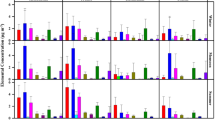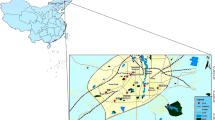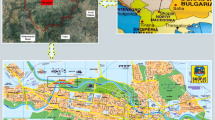Abstract
Airborne particulate matter (PM2.5 and PM10) samples were collected at the Beijing Normal University sampling site in the urban area of Beijing, China in dry and wet seasons during 2001–2004. Concentrations of 23 elements and 14 ions in particulate samples were determined by ICP-AES and IC, respectively. Source apportionment results derived from both Positive Matrix Factorization (PMF) and Chemical Mass Balance (CMB) models indicate that the major contributors of PM2.5 and PM10 in Beijing are: soil dust, fossil fuel combustion, vehicle exhausts, secondary particulate, biomass burning and some industrial sources. We have identified both regional common sources, such as vehicular emissions, particulate of secondary origin and biomass burning, as well as country-specific problems, such as sand storms and soil dust that should be addressed for effective air quality control.
Similar content being viewed by others
References
BEPB (Beijing Municipal Environmental Protection Bureau). Communique on the Environmental Status in Beijing in 2002 (in Chinese). Beijing Municipal Environmental Protection Bureau, 2003
Chameides W L, Yu H, Liu S C, et al. Case study of the effects of atmospheric aerosols and regional haze on agriculture: an opportunity to enhance crop yields in China through emission controls. Proc Nat Acad Sci USA, 1999, 96(24): 13626–13633
Winchester J W, Bi M. Fine and coarse aerosol composition in an urban setting: a case study in Beijing. Atmospheric Environment, 1984, 18(7): 1399–1409
Yang S J, Yang Y N, Qian Q F, et al. Characteristics of airborne particulate and identification of their sources in Beijing-Tianjin area. Acta Sci Circumstant (in Chinese), 1987, 7(4): 411–423
Dong J Q, Yang S J. Characteristics of the aerosol and study of their sources in Huabei clean area. Environ Chem (in Chinese), 1998, 17(1): 38–44
Wang W, Tang D G, Liu H J. Research on current pollution status and characteristics of PM2.5 in China. Res Environ Sci (in Chinese), 2000, 13(1): 1–5
Chen Z, Ge S, Zhang J. Measurement and analysis for atmospheric aerosol particulates in Beijing. Res Environ Sci (in Chinese), 1994, 7(3): 1–9
Yao X, Chan C K, Fang M, Cadle S. The water-soluble ionic composition of PM2.5 in Shanghai and Beijing, China. Atmos Environ, 2002, 36(26): 4223–4234
Yao X, Lau A P S, Fang M, Chan C K. Size distribution and formation of ionic species in atmospheric particulate pollutants in Beijing, China: 1-inorganic ions. Atmos Environ, 2003, 37: 2991–3000
He K B, Yang F M, Ma Y L, et al. The characteristics of PM2.5 in Beijing, China. Atmos Environ, 2001, 35: 4959–4970
Yao X H, Lau A P S, Fang M, et al. Size distributions and formation of ionic species in atmospheric particulate pollutants in Beijing, China: 2-dicarboxylic acids. Atmos Environ, 2003, 37: 3001–3002
Dan M, Zhuang G S, Li X X, et al. The characteristics of carbonaceous species and their sources in PM2.5 in Beijing. Atmos Environ, 2004, 38: 3443–3452
He L Y, Hu M, Huang X F, et al. Measurement of emissions of fine particulate organic matter from Chinese cooking. Atmos Environ, 2004, 38: 6557–6564
Wang Y, Zhuang G S, Tang A H, et al. The ion chemistry and the sources of PM2.5 aerosol in Beijing. Atmos Environ, 2005, 39: 3771–3784
Huang X F, Hu M, He LY, et al. Chemical characterization of water-soluble organic acids in PM2.5 in Beijing, China. Atmos Environ, 2005, 39: 2819–2927
Yang F M, Ye B M, He K B, et al. Characterisation of atmospheric mineral compounds of PM2.5 in Beijing and Shanghai. Sci Total Environ, 2005, 343: 221–230
Duan F K, He K B, Ma Y L, et al. Concentration and chemical characteristics of PM2.5 in Beijing, China. Sci Total Environ, 2006, 355: 264–275
Feng J L, Hu M, Chan C K, et al. A comparative study of the organic matter in PM2.5 from three China megacities in three different climatic zones. Atmos Environ, 2006, 40: 3983–3994
Huang X F, He L Y, Hu M, et al. Annual variation of particulate organic compounds in PM2.5 in the urban atmosphere of Beijing. Atmos Environ, 2006, 40: 2449–2458
Sun Y L, Zhuang G S, Wang Y, et al. The air-borne particulate pollution in Beijing— concentration, composition, distribution and sources. Atmos Environ, 2004, 38: 5991–6004
Yuan H, Wang Y, Zhuang G. The simultaneous determination of organic acid, MSA with inorganic anions in aerosol and rain-water by ion chromatography. J Instrum Anal (in Chinese), 2003, 6: 12–16
Paatero P. User’s Guide for Positive Matrix Factorization Programs PMF2 and PMF3. Helsinki: University of Helsinki, 1998
Ramadan Z, Song X H, Hopke P K. Identification of source of Phoenix aerosol by positive matrix factorization. J Air & Waste Manag Assoc, 2000, 50: 1308–1320
Hiena P D, Bacb V T, Thinhb N T H, et al. PMF receptor modeling of fine and coarse PM10 in air masses governing monsoon conditions in Hanoi, Northern Vietnam. Atmos Environ, 2004, 38: 189–201
Kima E, Larsonb T V, Hopke P K, et al. Source identification of PM2.5 in an arid Northwest U.S. City by positive matrix factorization. Atmos Res, 2003, 66: 291–305
Watson J G, Robinson N F, Lewis C, et al. Chemical mass balance receptor model version 8, (CMB8) User’s Manual, Desert Research Institute Document No. 1808.1D1, Desert Research Institute, 1997
USEPA, USEPA Speciate: VOC/PM speciation data system, User’s Manual, Version 3.1, USEPA, 1997
Ge S. Beijing aerosol characterization study: Influence of coal burning. Dissertation for the degree of Ph. D. submitted to the Oregon Graduate Institute of Science & Technology, University Microfilm International, DA9238754, 1992, 185
Author information
Authors and Affiliations
Corresponding author
Additional information
Supported by the Swedish International Development Cooperation Agency (SIDA), and coordinated by the Asian Institute of Technology
About this article
Cite this article
Zhang, W., Guo, J., Sun, Y. et al. Source apportionment for urban PM10 and PM2.5 in the Beijing area. CHINESE SCI BULL 52, 608–615 (2007). https://doi.org/10.1007/s11434-007-0076-5
Received:
Accepted:
Issue Date:
DOI: https://doi.org/10.1007/s11434-007-0076-5




